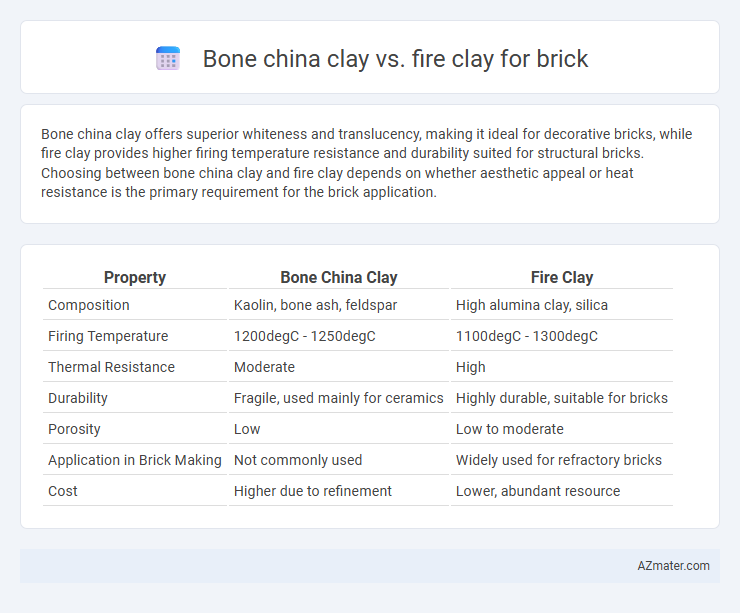Bone china clay offers superior whiteness and translucency, making it ideal for decorative bricks, while fire clay provides higher firing temperature resistance and durability suited for structural bricks. Choosing between bone china clay and fire clay depends on whether aesthetic appeal or heat resistance is the primary requirement for the brick application.
Table of Comparison
| Property | Bone China Clay | Fire Clay |
|---|---|---|
| Composition | Kaolin, bone ash, feldspar | High alumina clay, silica |
| Firing Temperature | 1200degC - 1250degC | 1100degC - 1300degC |
| Thermal Resistance | Moderate | High |
| Durability | Fragile, used mainly for ceramics | Highly durable, suitable for bricks |
| Porosity | Low | Low to moderate |
| Application in Brick Making | Not commonly used | Widely used for refractory bricks |
| Cost | Higher due to refinement | Lower, abundant resource |
Introduction to Bone China Clay and Fire Clay
Bone china clay is a refined, white-firing clay rich in kaolin, feldspar, and bone ash, known for its translucent, strong, and durable ceramic products. Fire clay contains higher alumina content and is prized for its excellent heat resistance and stability, making it ideal for firebricks and kiln linings. Differentiating these clays in brick manufacturing highlights bone china's use in fine ceramics versus fire clay's application in high-temperature industrial bricks.
Composition: Bone China Clay vs Fire Clay
Bone china clay primarily consists of kaolin, feldspar, and bone ash, which imparts high whiteness and translucency ideal for fine ceramics. Fire clay is rich in alumina and silica with minimal fluxes, providing superior heat resistance and structural strength suited for refractory bricks. The key compositional difference is bone china's calcium phosphate content from bone ash versus fire clay's higher alumina and silica concentration, influencing their respective thermal durability and aesthetic properties.
Physical Properties Comparison
Bone china clay exhibits finer particle size and higher plasticity compared to fire clay, resulting in better moldability and smoother surface finish in bricks. Fire clay possesses higher refractory properties and greater thermal stability, making it more resistant to high temperatures and thermal shock during firing processes. The density of bone china clay bricks is typically lower, offering improved strength and translucency, while fire clay bricks provide enhanced durability and resistance to abrasion.
Manufacturing Processes for Both Clays
Bone china clay requires precise blending of kaolin, feldspar, and bone ash, followed by a high-temperature firing process around 1250degC to 1300degC that results in a vitrified, translucent product. Fire clay for brick manufacturing involves shaping mixtures of silica and alumina-rich clays, then firing at temperatures between 1100degC and 1250degC to achieve durability, heat resistance, and low shrinkage. The manufacturing of bone china demands more refined raw materials and controlled thermal cycles, whereas fire clay bricks prioritize robustness and thermal stability through slightly lower firing temperatures and less stringent material purity.
Strength and Durability Analysis
Bone china clay exhibits superior strength and translucency due to its high kaolin and bone ash content, making it ideal for fine ceramics but less suited for heavy structural use. Fire clay, rich in alumina and silica, offers excellent thermal resistance and mechanical strength, enhancing the durability and load-bearing capacity of bricks used in high-temperature and industrial environments. The microstructure of fire clay bricks provides better resistance to deformation and spalling under thermal stress compared to bone china clay products.
Thermal Resistance in Bricks
Bone china clay, known for its fine particle size and high purity, provides moderate thermal resistance in brick manufacturing but is primarily valued for its translucency and strength rather than heat resistance. Fire clay, composed of highly refractory minerals with a high alumina content, offers superior thermal resistance, making it ideal for bricks exposed to extreme temperatures such as in kilns and fireplaces. The enhanced thermal stability of fire clay bricks prevents deformation and structural damage under prolonged heat exposure, outperforming bone china clay bricks in high-temperature applications.
Cost Implications: Bone China Clay vs Fire Clay
Bone china clay typically incurs higher costs compared to fire clay due to its refined composition and processing requirements. Fire clay is more economical, valued for its abundance and durability, making it a cost-effective choice for brick manufacturing. The price difference significantly impacts production budgets, especially in large-scale brick production where fire clay offers substantial savings without compromising quality.
Environmental Impact Assessment
Bone china clay, typically composed of kaolin, feldspar, and bone ash, shows lower environmental impact during extraction due to its limited mining areas and less intensive processing compared to fire clay. Fire clay, abundant and high in alumina content, often requires more energy-intensive firing at higher temperatures, resulting in greater carbon emissions and resource consumption in brick manufacturing. Environmental Impact Assessments reveal fire clay bricks contribute more significantly to greenhouse gas emissions and resource depletion, while bone china clay bricks, though less common, offer a more sustainable alternative with reduced ecological footprints.
Best Applications for Each Clay Type
Bone china clay is best suited for producing fine, translucent ceramics and delicate porcelain items due to its high kaolin content and plasticity, making it ideal for decorative and tableware bricks requiring a smooth finish. Fire clay, with its high refractory properties and resistance to thermal shock, is optimal for manufacturing firebricks used in high-temperature environments like kilns, furnaces, and fireplaces. Each clay type's unique mineral composition determines its suitability, with bone china clay preferred for aesthetic and low-temperature applications, while fire clay excels in structural and heat-resistant brick production.
Conclusion: Choosing the Right Clay for Bricks
Selecting the right clay for bricks depends on the desired durability and firing temperature. Bone china clay offers a finer texture and higher white firing temperature, making it suitable for decorative bricks with a smooth finish. Fire clay, with its higher plasticity and resistance to heat, is ideal for structural bricks requiring strength and thermal endurance.

Infographic: Bone china clay vs Fire clay for Brick
 azmater.com
azmater.com